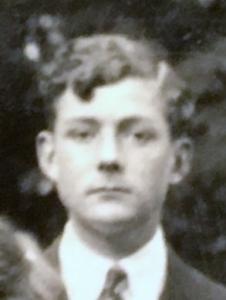
|

|
| Lieutenant Desmond Slavin Bowlby ROBERTS (271313) | |
|
D Company, 2nd Battalion Royal Warwickshire Regiment Date of birth: 17th May 1921 Date of death: 26th September 1944 Killed in action aged 23 Buried at Miero War Cemetery Plot V Row F Grave 7 |

|
| Desmond Slavin Bowlby Roberts was born at Paddington in London on the 17th of May 1921 the son of George Alexander Roberts, Headmaster of the Russell School Balford, and Alice May (nee Bowlby) Roberts of "Fairlights", Limpsfield in Surrey. He was educated at Lancing College where he was in Seconds House from September 1935 to December 1938. He gained his School Certificate in 1938. On leaving school he went to work for Lever Bros. He was commissioned as a 2nd Lieutenant on the 23rd of April 1943 and was posted as a platoon commander to B Company, 2nd Battalion Royal Warwickshire Regiment. He was promoted to Lieutenant on the 23rd of October 1943. On the 4th of June 1944 he embarked with his battalion for the invasion of France and they set sail at 9pm that night. The battalion landed at 9.55am on the 6th of June 1944 at Lion-Sur-Mer where the beach was still under shell and mortar fire as well as sniper fire from houses along the sea front. By 11.30am the battalion had assembled to the south of the town having suffered a few casualties. At 6.30pm A Company successfully attacked enemy positions at Benouville while B Company moved towards Blainville meeting opposition throughout their journey. The battalion stopped for the night at Blainville. After heavy casualties in the Normandy fighting the battalion was reorganised with B and C Companies being rolled into D Company. On the 23rd of September 1944 the battalion crossed into Holland and at 9am they moved in transport to Asten, where the 11th Armoured Division was still clearing the bridgehead. After a long wait the battalion moved into Asten at 16.00 hours, taking up positions to the north and east of the town with the 1st Battalion Norfolk Regiment in the west and the 2nd Battalion King's Shropshire Light Infantry protecting the bridge over the canal. There was some light incoming shelling during this period. During the night patrols were sent out which brought back prisoners and found that the Germans were in strength along the Asten-Meljel Road, 1,000 yards from the town. The following day D Company were ordered to clear the enemy from the area and at 3pm they moved to the attack, supported by artillery fire from the 7th Field Regiment, Royal Artillery. Soon after moving forward they came under shell, mortar and small arms fire from the village of Heusden but by nightfall they had established a small foothold in that village. D Company had lost Desmond Roberts and Lieutenant Robert John Keast, Royal Canadian Infantry Corps attached and two other ranks killed and twelve other ranks wounded. The company was withdrawn from the village after dark and it was heavily shelled in preparation for a renewed attack in the morning. When patrols were sent out the next day it was found that the Germans had retreated. He is commemorated on the war memorial at Limpsfield in Surrey. |
|
| Seconds House |
Back